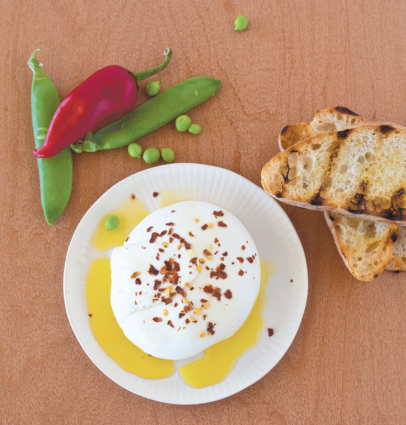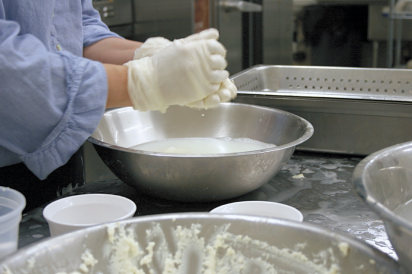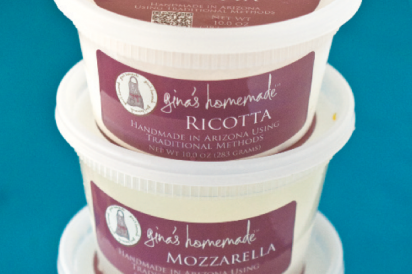Hands-On Approach Yields Superior Cheeses
Gina Buskirk is standing at a stainless steel counter, sleeves rolled up and a clean apron tied around her small frame. Her long, dark hair is swept neatly back from her face, restrained by a hairnet. She is rhythmically plunging her gloved hands in and out of a wide steel bowl of murky, steaming water.
Two industrial-size stockpots fitted with thermometers sit on the stove behind her. One is filled with curdled milk, on its way to becoming ricotta. The other is filled with hot whey. Four layers of plastic gloves cover Gina's hands because the watery whey she pours over the curds in the bowl is only a few degrees shy of boiling. She is finessing a mass of curds into a soft, supple cheese, but her brow is furrowed.
"Today," she says slowly, her espresso-colored eyes focused intently on the mass in the water, "the curd is a little … more … fragile than usual, a little … more … fussy."
Why, I ask?
"Because you're here, of course," she says with a laugh. Of course, I say.
I've come to observe the Gina from Gina's Homemade make mozzarella and burrata, and like a watched kettle that never boils, the curds have decided to display a finicky streak.
A perforated pan of curds she made earlier that morning sits to the left of the massive bowl where Gina massages the mozzarella, gently pulling and shaping the mound until it shines. Just a few pulls and she's gathered it up into a ball.
"I like to give it the love knot," she says as she pinches the ball underneath. She transfers the smooth, mostly round ball with the love knot into a bowl of ice water so it will set. "If you put it in room-temperature water, the cheese flattens out," she says.
Gina's fresh cheeses are generating buzz in the local food community. Cheese wasn't her first product when she came to the market in late 2010– it was biscotti, which she still makes and which, rightly so, have their own devout following.
But today I've come to see the cheesemaker and find out how–and why–she's carved out a niche producing artisanal fresh cheeses.
A Family Affair
Gina and her husband, Chris, who she says is the left brain of the company, have one full-time employee but otherwise it's just the two of them. She is the cheesemaker, the biscotti baker and, more recently, the soup maker, while Chris is the business manager, the sales and marketing guy and Gina's number one fan.
Their four children, ages 5 to 13, also pitch in, mostly at the Scottsdale Old Town Farmers' Market on Saturday mornings. They hire part-time employees to work other markets and sample their cheeses at Whole Foods and AJ's Fine Foods, but it is a small, family-run operation. Family is important–and, in some respect, family is everything to Gina and Chris.
They both come from large Italian families. Her family is from Abruzzo and a tiny fishing island called Ponza. Three of her four grandparents emigrated from Italy and settled in Michigan, just outside of Detroit. Chris's family hails from south of Naples, but he was born in Germany while his Army father was stationed there in the late 1960s.
The pair met serendipitously 15 years ago when they sat next to each other at a rehearsal dinner as part of a wedding for mutual friends. Forty-eight hours later they were engaged, but it would be another year before they married, at the request of Gina's father. Once married, the couple settled in Arizona, where Chris has lived since he was 7. Gina set about raising their four children while Chris built up and sold an insurance business, and then joined a commercial equipment leasing business. He now splits his time between the leasing business and Gina's Homemade.
Part Science, Part Art
Like many Italians, Gina talks with her hands. "Back in the day, before all this craziness," she says gesturing to the rented commercial kitchen where she makes her cheeses, biscotti and soups for the farmers' markets, "I made hundreds of batches of mozzarella at 2am and I'd say, 'It's not working!'" Even miniscule variations in water temperature and fat content of the milk can make the difference between a soft, supple, milky cheese and a blob of stringy, tough rubber.
Gina's first cheese to market was ricotta, followed quickly by mozzarella and burrata. She eventually added mascarpone and crème fraîche to the mix. The newest cheese is similar to a fromage blanc, although she calls it "the new cheese spread" because she hasn't come up with a name for it.
Gina is now stretching a mass of mozzarella instead of forming it into a ball. She stretches the flat, five-inch disk over the top of a ramekin and places a scoop of fluffy but roughly textured white stuff in the center and folds the mozzarella over the creamy mass, giving it her signature love knot to seal it. Gina "doctors" her filling of cream and salted curds, whipping them to a cottony texture.
"This," she says as she gently molds the mound into a smooth ball, "is burrata."
After the burrata chills in the ice water bath, it goes into a labeled plastic container filled with brine. "The brine will soften the cheese over the next few hours," she says, as well as extend the shelf life from a couple of days to a couple of weeks.
Gina keeps track of her daily cheese production on a large white board, a recent gift from her children who pooled their cash to buy their mom a gift she sorely needed. It sits on the floor because the kitchen is shared, rented by the day or week, and tenants aren't allowed to hang anything on the wall. Across the top are the cheese products and down the side is a growing list of customers: restaurants such as Beckett's Table and stores such as AJ's and Whole Foods.
It's All About the Milk
The Buskirks say one of the biggest challenges in selling their cheese is explaining why they don't use a local source for milk. "In cheese, especially the fresh cheeses we make," Gina says, "the quality of the milk is paramount."
Chris says they searched in vain for local milk that met their taste standards and that wasn't homogenized. Homogenizing milk breaks up fat globules into tiny particles so that the fat content stays evenly distributed through out the milk: good for drinking, but bad for cheesemaking. He says that Arizona milk is produced in mass for a mass market, so they looked elsewhere, and found a California family farm with pastured dairy cows, free of hormones and antibiotics. More importantly, the milk is not homogenized.
Chris and Gina hope the business grows to the point where they can hire and train other cheesemakers and have their own commercial kitchen, but Chris says they will never mechanize their product. "I've seen machines that take milk in one end and out come little balls of mozzarella on the other," he says. "They're not bad cheeses, they're just not as good as ours."
He also says the retail price point of some mass-produced mozzarella is far below his costs. Still, he thinks there is a market for their cheeses and each month they are producing more and picking up new clients.
He says they are relying less on the income from the equipment leasing business, and focusing more on growing the cheese business. "This," he points to his wife, her hands back in the scalding whey, "is our future."
GINA'S HOMEMADE FRESH COW'S MILK AND CHEESE PRODUCTS
Burrata – mozzarella stretched and filled with a mixture of curds and cream and twisted closed, and stored in brine. The cream thickens, creating a soft, creamy, milky interior.
Crème fraîche – not a cheese, but instead thickened, mature cream with a soft, sour cream texture and slight tang.
Fromage blanc – uncooked, unmolded and unripened fresh cheese, with a texture and taste of thick sour cream, sometimes seasoned with herbs and spices. Generally used as a spread.
Mascarpone – milk enriched with cream and thickened with citric acid. Smooth, rich and buttery.
Mozzarella – made from whole milk curds dipped in hot whey, stretched and kneaded into a soft, supple ball and stored in brine.
Ricotta – ricotta means "recooked" referring to the use of leftover whey, but it is often made with fresh curds and whey. Curds rise to the top of heated whey and are skimmed off and hung in molds or baskets to drain.







